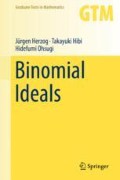Abstract
In this chapter we recall basis concepts from commutative algebra which are relevant for the subjects treated in the later chapters. We begin with a review on graded rings, Hilbert functions, and Hilbert series, and introduce the multiplicity and the a-invariant of a graded module. The Krull dimension of a graded module will be defined in terms of its Hilbert series. We will give various characterizations of the depth of a module and its relation to the Krull dimension. These considerations lead to Cohen–Macaulay modules and Gorenstein rings. We then describe the relationship, known as Auslander–Buchsbaum formula, between the depth of a graded S-module M and its projective dimension, where S is a polynomial ring, and study in more detail the finite minimal graded free S-resolution of M. The regularity of M will be defined via this resolution. Koszul algebras are standard graded K-algebras whose graded maximal ideal has a linear resolution. Unless this graded ring is a polynomial ring, this resolution is infinite. We discuss various necessary and sufficient conditions for Koszulness. The methods involved include Gröbner bases and Koszul filtrations.
Access this chapter
Tax calculation will be finalised at checkout
Purchases are for personal use only
References
Anick, D.: A counterexample to a conjecture of Serre. Ann. Math. 115, 1–33 (1982)
Avramov, L.: Infinite free resolutions. In: Elias, J., Giral, J.M., Miró-Roig, R.M., Zarzuela, S. (eds.) Six Lectures on Commutative Algebra. Progress in Mathematics, vol. 166, pp. 1–118. Birkhäuser, Basel (1998)
Backelin, J., Fröberg, R.: Koszul algebras, veronese subrings and rings with linear resolutions. Rev. Roum. Math. Pures Appl. 30, 85–97 (1985)
Bass, H.: On the ubiquity of Gorenstein rings. Math. Z. 82, 8–28 (1963)
Bruns, W., Herzog, J.: Cohen–Macaulay Rings. Cambridge Studies in Advanced Mathematics, vol. 39. Cambridge University Press, Cambridge (1993)
Conca, A., Rossi, M.E., Valla, G.: Gröbner flags and Gorenstein algebras. Compos. Math. 129, 95–121 (2001)
Conca, A., Trung, N.V., Valla, G.: Koszul property for points in projective space. Math. Scand. 89, 201–216 (2001)
Eisenbud, D.: Commutative Algebra with a View Toward Algebraic Geometry. Graduate Texts in Mathematics. Springer, New York (1995)
Ene, V., Herzog, J.: Gröbner Bases in Commutative Algebra. Graduate Studies in Mathematics. American Mathematical Society, Providence (2012)
Ene, V., Herzog, J., Hibi, T.: Cohen–Macaulay binomial edge ideals. Nagoya Math. J. 204, 57–68 (2011)
Fröberg, R.: Determination of a class of Poincaré series. Math. Scand. 37, 29–39 (1975)
Fröberg, R., Koszul algebras. In: Dobbs, D.E., Fontana, M., Kabbaij, S-E. (eds.) Advances in Commutative Ring Theory (Fez 1997). Lecture Notes in Pure and Applied Mathematics, pp. 337–350. M. Dekker, New York (1999)
Gulliksen, T.H.: A proof of the existence of minimal algebra resolutions. Acta Math. 120, 53–58 (1968)
Herzog, J.: Algebra retracts and Poincare series. Manuscripta Math. 21, 307–314 (1977)
Herzog, J., Hibi, T.: Monomial Ideals. Graduate Texts in Mathematics. Springer, New York (2010)
Herzog, J., Hibi, T., Restuccia, G.: Strongly Koszul algebras. Math. Scand. 86, 161–178 (2000)
Löfwall, C.: On the subalgebra generated by one-dimensional elements in the Yoneda Ext-algebras. In: Roos, J.E. (ed.) Algebra, Algebraic Topology and their Interactions. Lecture Notes in Mathematics, vol. 1183, pp-291–338. Springer, New York (1986)
Ohsugi, H., Herzog, J., Hibi, T.: Combinatorial pure subrings. Osaka J. Math. 37, 745–757 (2000)
Priddy, S.B.: Koszul resolutions. Trans. AMS 152, 39–60 (1970)
Schoeller, C.: Homologie des anneaux locaux noethérien. C.R. Acad. Sci: Paris Sér. A 265, 768–771 (1967)
Tate, J.: Homology of noetherian rings and local rings. Ill. J. Math. 1, 14–25 (1957)
Weibel, C.A.: An Introduction to Homological Algebra. Cambridge Studies in Advanced Mathematics vol. 38. Cambridge University Press, Cambridge (1994)
Author information
Authors and Affiliations
Rights and permissions
Copyright information
© 2018 Springer International Publishing AG, part of Springer Nature
About this chapter
Cite this chapter
Herzog, J., Hibi, T., Ohsugi, H. (2018). Review of Commutative Algebra. In: Binomial Ideals. Graduate Texts in Mathematics, vol 279. Springer, Cham. https://doi.org/10.1007/978-3-319-95349-6_2
Download citation
DOI: https://doi.org/10.1007/978-3-319-95349-6_2
Published:
Publisher Name: Springer, Cham
Print ISBN: 978-3-319-95347-2
Online ISBN: 978-3-319-95349-6
eBook Packages: Mathematics and StatisticsMathematics and Statistics (R0)

